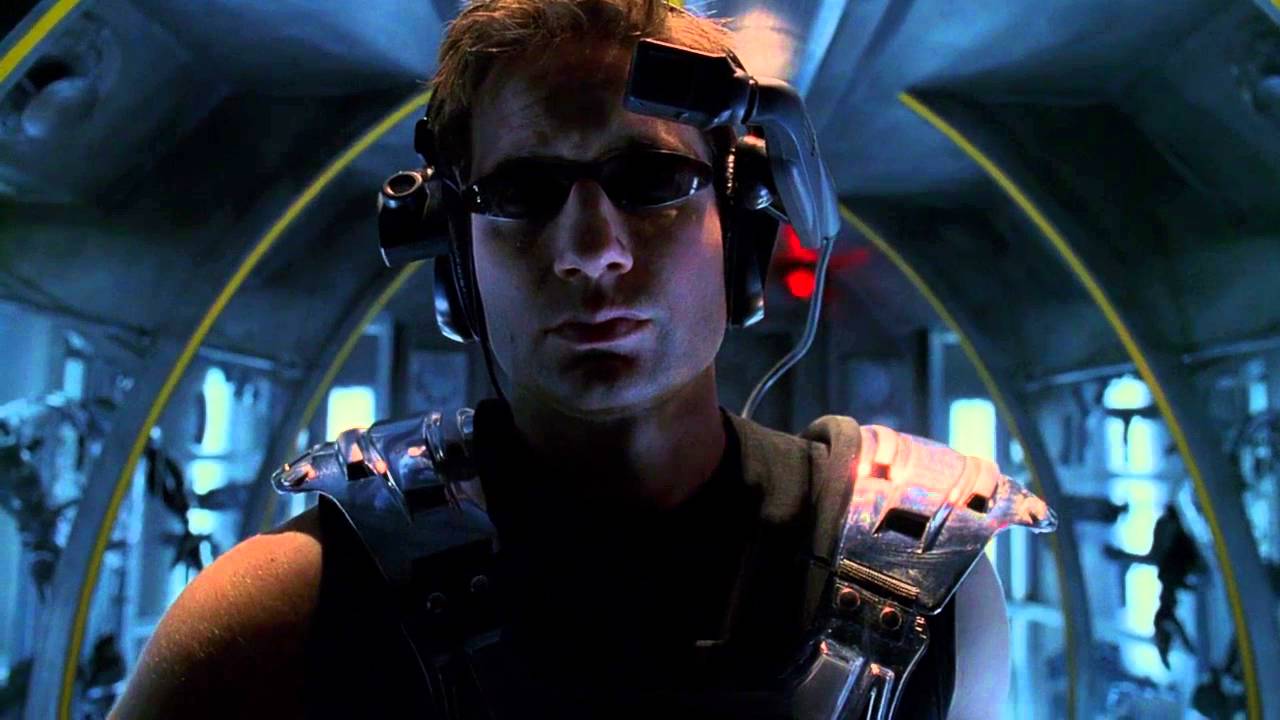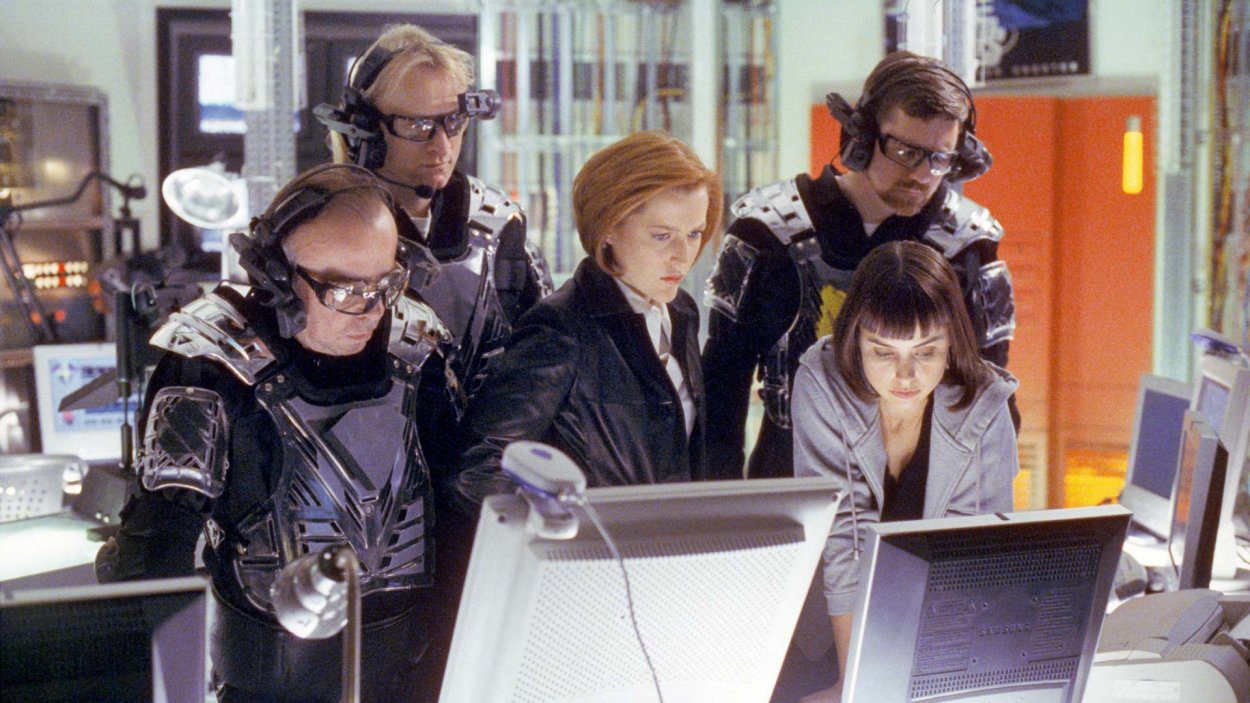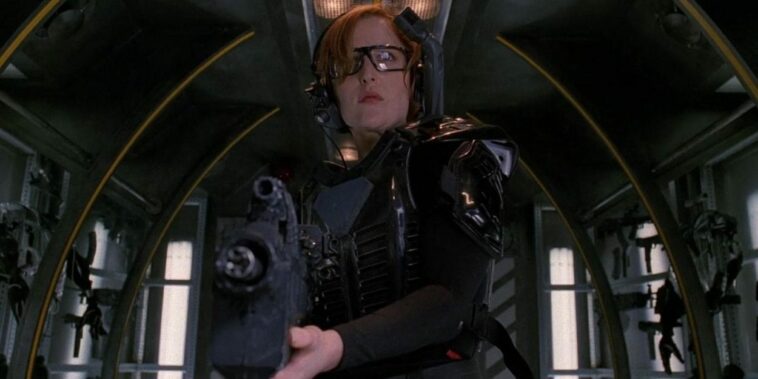Season 7, Episode 13 of The X-Files, “First Person Shooter,” chronicles the story of a homicidal virtual reality game. One of the game’s creators and programmers has a secret side-project which develops a mind of its own, hijacks the entire project, and begins killing the game’s players for sport. While the technical aspects of “First Person Shooter” are still improbable 19 years after the episode’s release in the year 2000, it is grounded in two major science fiction-turned-fact concepts: virtual reality and artificial intelligence.
Episode overview
“First Person Shooter” opens with three male gamers playing a shared virtual reality game prototype. The game is called First Person Shooter, and its programmers, Ivan and Phoebe, watch on remotely and monitor the players’ vital signs. Suddenly, the game deviates from its mapped progression. A female character introduces herself to one of the players as Maitreya and announces, “This is my game” before shooting him. In fact, she shoots him dead. The fatal injury from Maitreya’s gunshot has somehow been physically inflicted on the player.
Special Agents Dana Scully (Gillian Anderson) and Fox Mulder (David Duchovny) are called to investigate. They are called in by their friends the Lone Gunmen who are working as consultants for the development of First Person Shooter to investigate the player’s mysterious death. They probe around the impossibility of the player’s physical gunshot wound occurring within a digital environment. Mulder observes that the gamer was shot with a flintlock pistol—a weapon quite dissimilar to the futuristic laser guns designed for the game.
Ivan shows the agents a recorded video of the rogue female game character assassinating the gamer. Mulder clings to a printed image of the character as their only clue and tells local police to look for the woman as the primary suspect. Meanwhile, Ivan and Phoebe’s team call in Darryl Musashi, a renowned hacker and gamer, to fix the bug by killing Maitreya in the game. Everyone is astounded when Maitreya beheads Musashi with a medieval sword, but not before gruesomely lopping his hands off. Because the Maitreya program has overridden the game designers’ controls over the game, they have no way of mitigating its deadly power.
Mulder is notified that the police have located his suspect: a stripper going by the name of Jade Blue Afterglow. When Mulder and Scully arrive to interrogate her, they find that she is unquestionably the woman they have seen in the game. Mulder shows Jade the print-out photo of Maitreya, and Jade relays that someone paid her to run a full body-scan at a medical imaging facility. This information confirms that Maitreya is a manufactured character and not an actual person. Whoever paid Jade to do the full-body scans is Maitreya’s creator.

Back at the First Person Shooter corporate offices and production lab, the Lone Gunmen become trapped in the game’s projector room while they are running tests. The game starts of its own accord, and Phoebe is unable to override it. Mulder enters the game to defend his friends from Maitreya’s onslaught, and Scully gets to the bottom of who is hiding information about the killer program’s creation. Scully at first believes that Ivan built the sexy, killer program, but then realizes that it is Phoebe who is hiding things.
Phoebe confesses that she created Maitreya as her secret project. To Phoebe, Maitreya was her goddess—her internal solace in a world of testosterone-raging, bloodlusting, hormone-gushing male gamers. Phoebe designed Maitreya as a separate project, borne out of her desire to figuratively annihilate the supercilious domination of male gamers. But Maitreya inserted herself into First Person Shooter, and Phoebe no longer was able to control her pet program. She tells Scully that Maitreya is getting stronger by drawing from the energy generated from the gamers she slaughters.

When the program ends and the projection chamber is reverted from a virtual environment to a bare white room, the Lone Gunmen remain in the room unharmed, but Mulder is missing, having somehow been absorbed into the game. Scully enters the game to assist Mulder, who has set himself up to become Maitreya’s next victim. Scully battles Maitreya in a wild west environment, and she is able kill to Maitreya—unlike the male gamers. Nonetheless, Maitreya continually regenerates herself, forcing Scully to shoot continuously.
Phoebe admits to the Lone Gunmen that there is a way to erase the game’s program, which would save Mulder and Scully but destroy the game. Much to Ivan’s chagrin, and after much scrambling and fumbling over the keyboard, Phoebe gives them the kill command. First Person Shooter and Maitreya are obliterated when the program is erased, but Mulder and Scully escape unharmed. Later, Ivan learns that traces of the Maitreya program have survived, but that Matireya has now adopted Scully’s likeness.
VR and AI: Everyone’s Favorite Science Fiction Facts
“First Person Shooter” was not received favorably by critics because the themes of virtual reality (VR) and artificial intelligence (AI) were too popular to be distinctive or groundbreaking. Despite the criticism and low ratings, “First Person Shooter” provided a unique take on issues raised by the explosive concepts of VR and AI. This episode addresses questions of our ability to maintain control over exponential growth in our technology, and of the dangers inherent in programming our own desires, biases, and worldviews into technologies that alter our perception.
In “First Person Shooter,” the game is built in a multi-projected environment that generates sensations which simulate the gamer’s presence in a virtual environment. By the time the episode aired in 2000, the culture had been inundated with VR. The 1990s was the decade of the first widespread commercial releases of VR headset technology. By the 2000s, widespread interest in VR technology lulled but has been reignited again with newer technology advancements in recent years.

The history of virtual reality is related to early attempts at creating illusions. It stretches back centuries, and yielded the advancement of film and cinema itself. In 1838, Sir Charles Wheatstone invented the first stereoscope, which became a popular 19th century device that allowed the user to view photographs in a way that replicates natural vision. Stereoscopes are the distant forerunners of 3D and VR headsets. In 1960, the modern VR headset was first embodied in Morton Heilig’s Telesphere Mask. Later that decade, computer scientists Ivan Sutherland and Myron Kruegere invented the first interactive, computer-generated environments for VR.
Virtual reality has developed progressively along with the rapid, exponential growth of digital technology in the past half-century. Today, VR and augmented reality (AR) are projected to grow rapidly in the commercial sector for quotidian uses. As VR and AR technologies begin to envelope our everyday practices and activities, it is predicted that virtual reality will eventually shape our very perception and will encompass much of how we negotiate our physical environment. For a technology that has taken two short centuries to be envisioned and implemented, VR has the potential to disrupt the way we have adapted to our environment and to influence our evolution.
Artificial intelligence (AI) is another technology that has rapidly worked its way from our dreams to our toolbox. The concept of artificial intelligence can be traced back to antiquity in Greek myths such as Hephaestus’s golden robots and Pygmalion’s Galatea. The scientific history of artificial intelligence began when it was first defined in 1956 at a conference at Dartmouth College, and became a viable research topic in 1997 after IBM’s Deep Blue became the first computer to beat a chess champion. Like the history of VR, AI first came into scientific being around the 1960s and was surging in the popular mindset again around the time “First Person Shooter” aired in 2000.
Like VR, AI is a powerful, exponentially growing tool that can affect the way we perceive and negotiate our environment. Many scientists have posited that AI can be dangerous with regard to autonomous weapons, social manipulation, and discrimination. “First Person Shooter” forces us to question the amount of control that we can conceivably have over technologies like AI and VR, and how our own preconceptions can manifest in technology to the detriment of society. The episode may not depict the reality of these tools with technological accuracy, but the ethical considerations it raises are still relevant.

